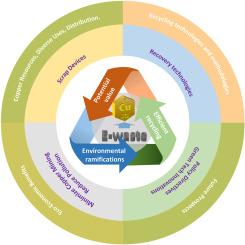实现资源再生:关注从电子废物中回收铜
IF 9.7
1区 环境科学与生态学
Q1 ENGINEERING, ENVIRONMENTAL
引用次数: 0
摘要
预计到 2030 年,电子垃圾的数量将上升到 7470 万吨,其特点是成分和设计复杂,包含 1000 多种潜在有毒物质和重金属,如铬和铜。随着电子电气设备、发电和输电行业的快速发展,全球对精炼铜的需求在过去 50 年里急剧增加,规模几乎翻了一番。值得注意的是,在过去二十年中,中国每年从国际市场进口的废铜超过 200 万吨,造成了进口依赖和国内铜资源的枯竭。本文对从电子废弃物中回收铜资源的发展轨迹进行了前瞻性分析,深入探讨了这一重要组成部分的潜在价值、回收方法和环境影响。从铜的资源分布、回收技术、环境和社会影响等多个角度,对电子废弃物中铜的回收价值进行了全面评估。火法冶金虽已初步发展,但效率和纯度较低。相比之下,建立在火法冶金学基础上的湿法冶金学提高了效率,铜浸出率超过 90%,但代价是对环境造成影响。此外,新兴的生物浸出工艺也在不断进步,提供了一种前景广阔的策略。此外,本文还概述了该领域未来的发展方向,旨在更有效地应对电子废物管理的挑战,促进有价值铜金属的高效回收和再利用。本文章由计算机程序翻译,如有差异,请以英文原文为准。

Towards Resource Regeneration: A Focus on Copper Recovery from Electronic Waste
It is projected that by 2030, the volume of electronic waste will escalate to 74.7 million tons, characterized by intricate compositions and designs, encompassing over 1000 potential toxic substances and heavy metals such as chromium and copper. Amidst the rapid advancements in electrical and electronic equipment, power generation, and transmission sectors, the global demand for refined copper has surged dramatically over the past five decades, nearly doubling in scale. Notably, China has annually imported over 2 million tons of scrap copper from international markets over the past two decades, fostering import dependency and depleting domestic copper resources. This paper conducts a forward-looking analysis of the development trajectory of copper resource recovery from e-waste, delving into the potential value, recovery methods, and environmental implications of this crucial component. From multiple perspectives, including copper's resource distribution, recovery technologies, and environmental and societal impacts, a comprehensive evaluation of the recovery value of copper in e-waste is undertaken. Pyrometallurgy, though initially developed, suffers from low efficiency and purity. In contrast, hydrometallurgy, built upon pyrometallurgy, enhances efficiency, achieving copper leaching rates of over 90%, albeit at the cost of environmental consequences. Furthermore, the emerging bioleaching process continues to progress, offering a promising strategy. Additionally, this paper outlines the prospective directions for future development in this field, aimed at addressing the challenges of e-waste management more effectively and fostering the efficient recovery and reuse of valuable copper metals.
求助全文
通过发布文献求助,成功后即可免费获取论文全文。
去求助
来源期刊

Journal of Cleaner Production
环境科学-工程:环境
CiteScore
20.40
自引率
9.00%
发文量
4720
审稿时长
111 days
期刊介绍:
The Journal of Cleaner Production is an international, transdisciplinary journal that addresses and discusses theoretical and practical Cleaner Production, Environmental, and Sustainability issues. It aims to help societies become more sustainable by focusing on the concept of 'Cleaner Production', which aims at preventing waste production and increasing efficiencies in energy, water, resources, and human capital use. The journal serves as a platform for corporations, governments, education institutions, regions, and societies to engage in discussions and research related to Cleaner Production, environmental, and sustainability practices.
 求助内容:
求助内容: 应助结果提醒方式:
应助结果提醒方式:


